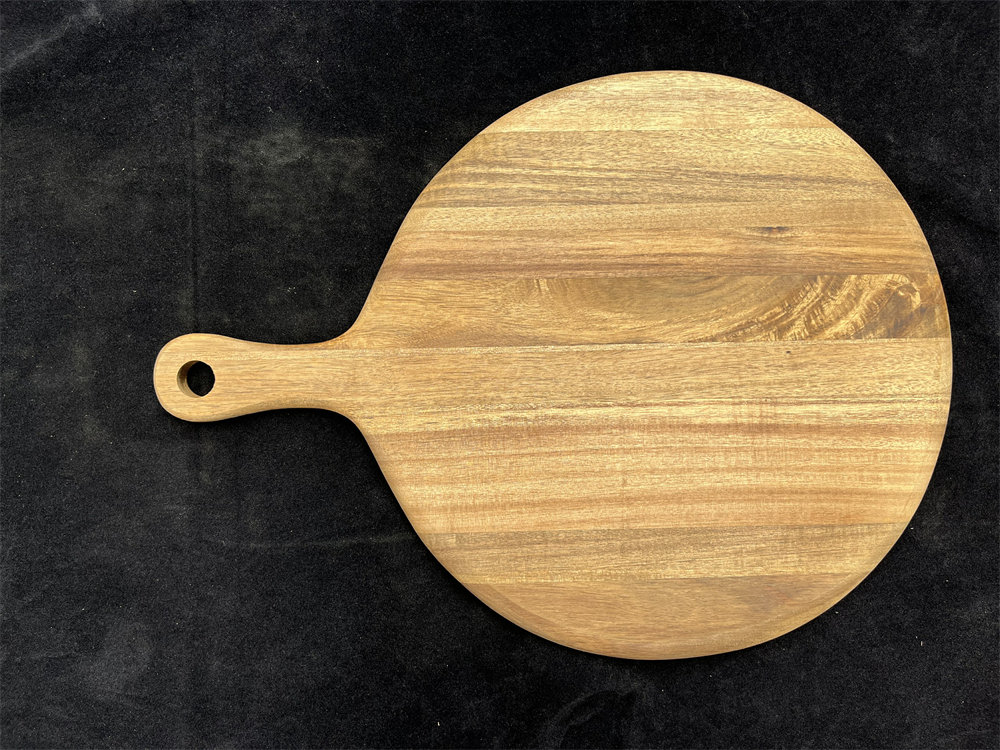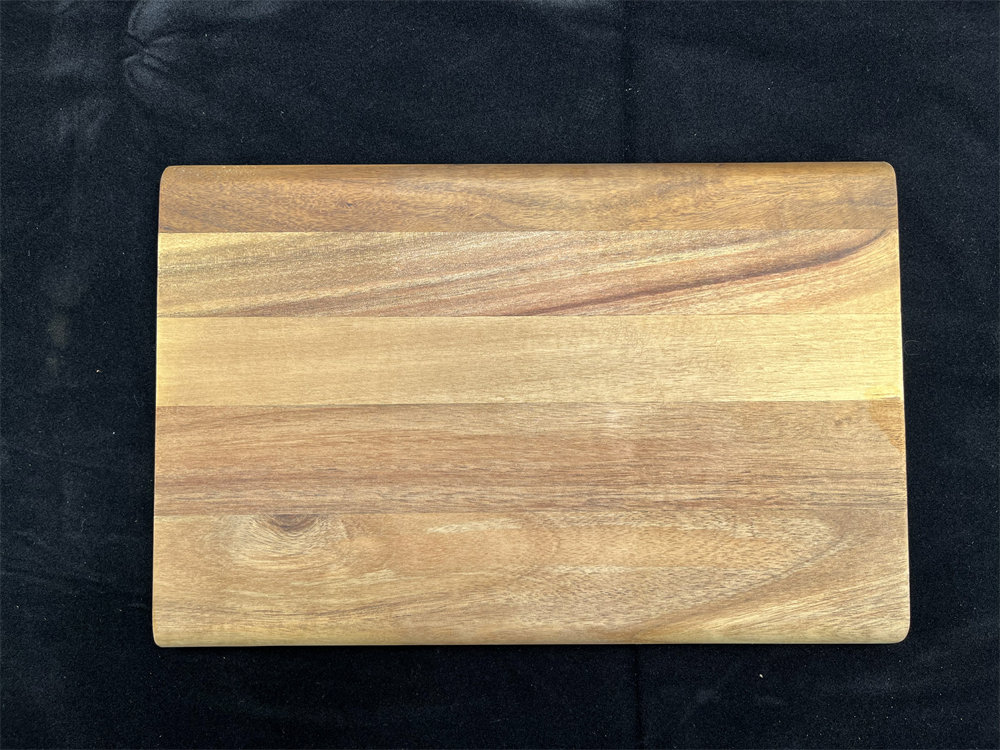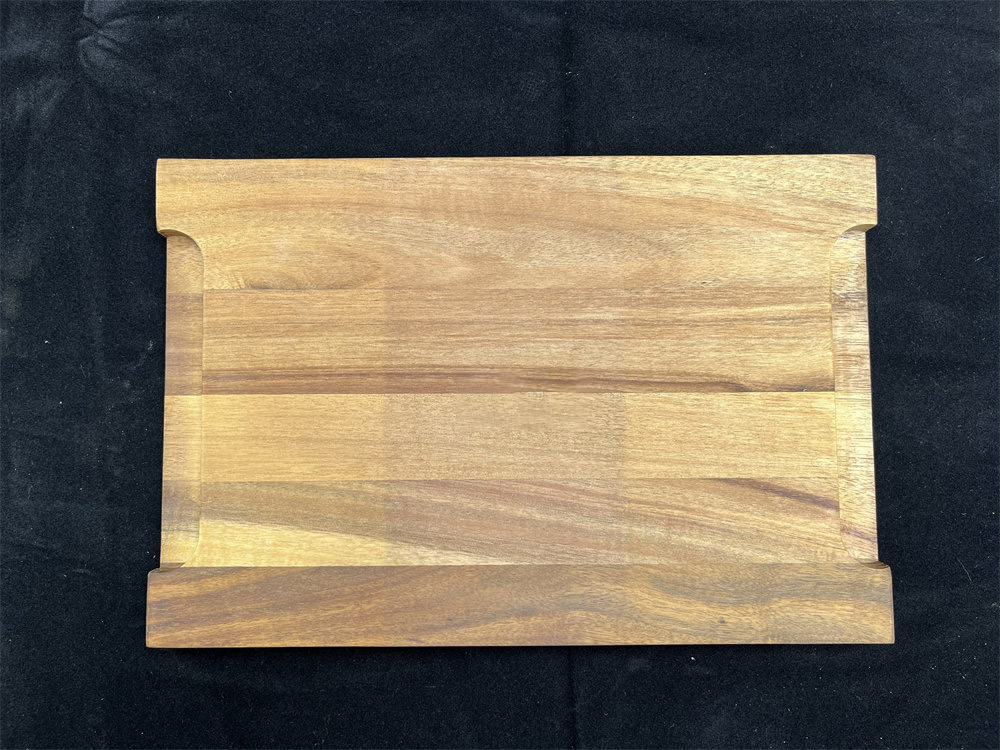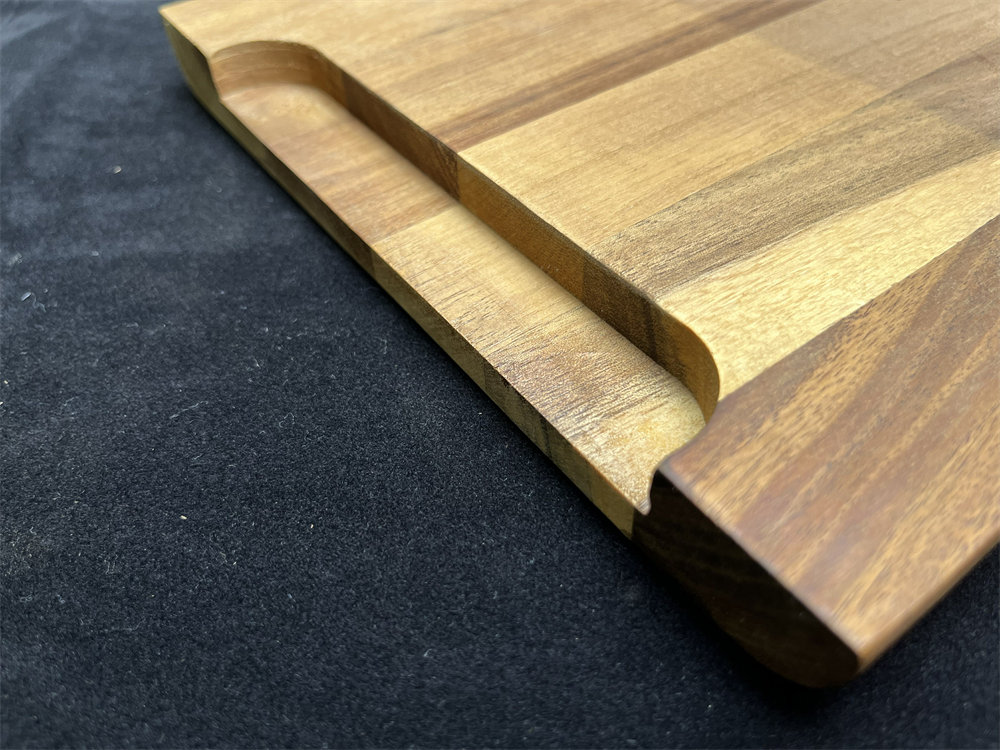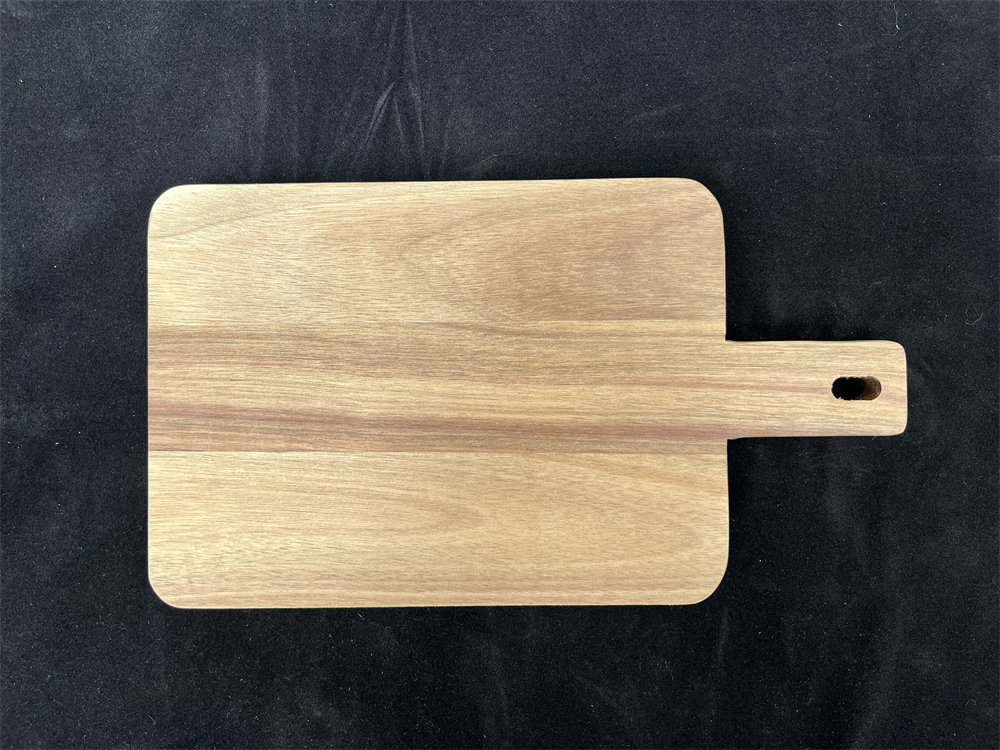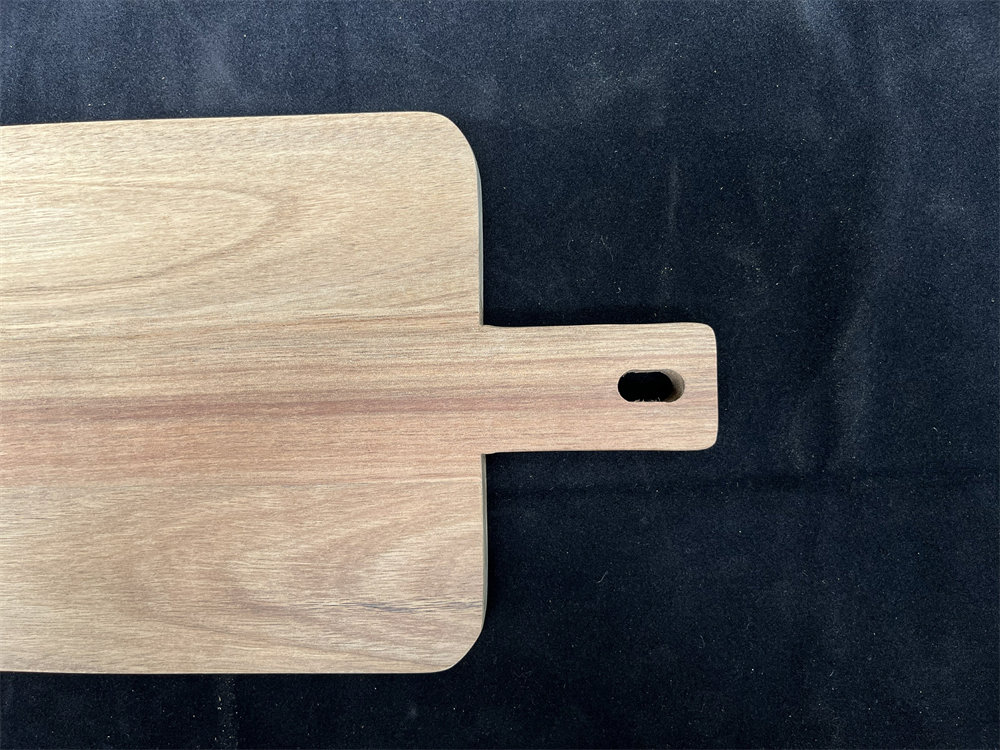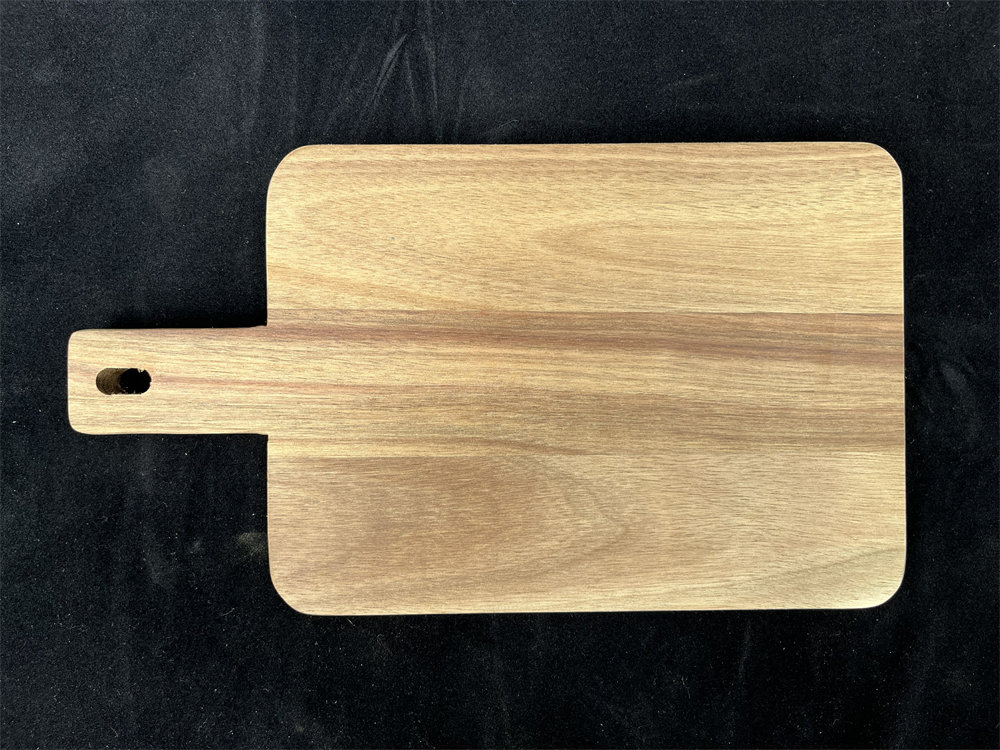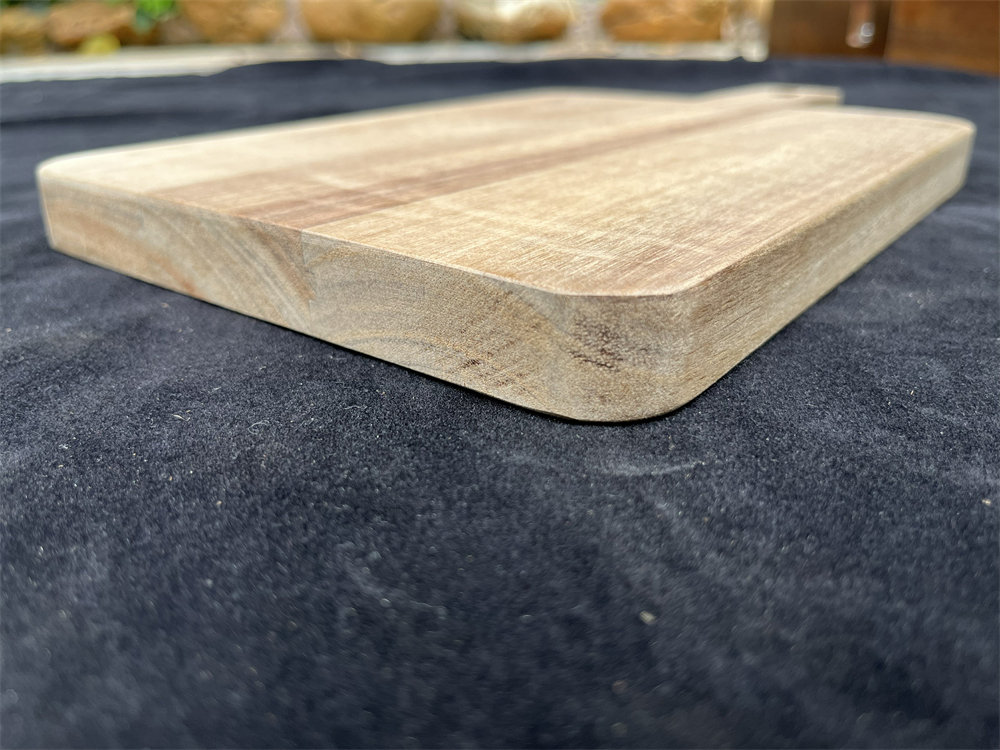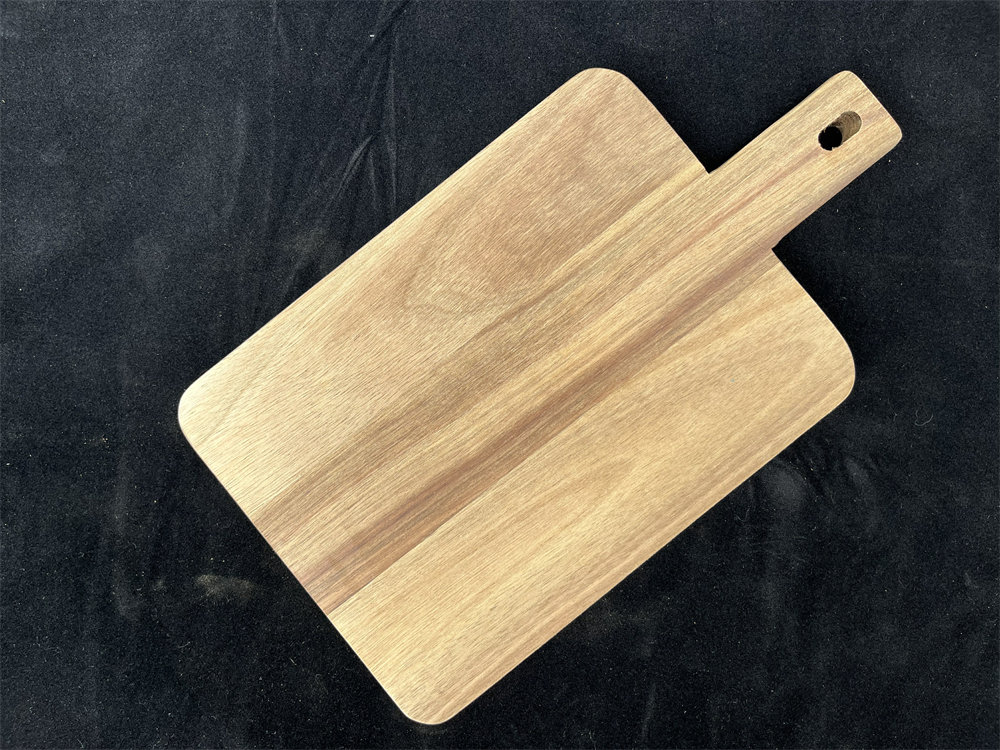Solid Wood Bread Board
- Product Information
Solid Wood Bread Board is a kitchen utensil made of natural acacia wood. It is rectangular in shape and its surface is treated with varnish or edible oil, making it waterproof and stain-resistant. The whole wood structure ensures its stability and durability. There is a handle on one side for easy picking and moving. In addition, its edges are finely chamfered, smooth and safe. Whether it is daily use at home, bakery display, or restaurant service, it is a practical tool for handling bread.
.
Solid Wood Bread Board Specifications:
| Model Number: | XYL-WCB009HA |
| Product name: | Acacia wood cutting board with handle |
| Material: | Acacia wood |
| Shape: | Rectangle |
| Size: | 32x18x2.0cm |
| Surface finish: | Lacquer or edible grade oil |
| Color: | Natural |
| Packing: | Poly bag + inner box + export carton |
| Place of Origin: | Guangdong China |
| MOQ: | 300 SETS |
| Lead time: | 30-35 Days |
| Shipping way: | Sea shipment, air shipment or express |
Solid Wood Bread Board Features:
High-quality wood material
The Acacia wood used in this Solid Wood Bread Board is a very advantageous hardwood. From a physical property point of view, the average air-dry density of Acacia wood is about 0.7 - 0.8g/cm³, which shows that it has a high density, making the breadboard excellent in hardness. High density means that it can better resist the cutting pressure of the knife. In actual tests, a common bread knife is used to cut with normal force. After hundreds of cuts, only slight and superficial scratches appear on the surface of the breadboard, which will not affect its overall structure and use function. Acacia wood also has natural antibacterial properties. According to professional testing, its antibacterial rate against common bacteria such as Escherichia coli and Staphylococcus aureus can reach more than 90%. This is because Acacia wood contains some natural antibacterial ingredients that can effectively inhibit the growth and reproduction of bacteria, providing reliable protection for food hygiene. Moreover, the unique texture of Acacia wood is beautiful and natural. The texture of each breadboard is unique, adding natural beauty and unique personality to the product.
Reasonable size design
The breadboard measures 32x18x2.0cm, and this size design is carefully considered. The length of 32cm can well adapt to the size of most breads. Whether it is a long baguette or a medium-sized ordinary bread, it can be placed and cut steadily on the breadboard. In actual use scenarios, when cutting a baguette about 30cm long, the breadboard can provide enough space for the knife to move freely and complete uniform cutting. The width of 18cm provides ample space for cutting operations, avoiding the situation where the bread or knife slides out of the board during the cutting process, and improving the stability and safety of the operation. The thickness of 2.0cm ensures that the breadboard has good stability and durability, and it is not easy to deform or break when subjected to repeated cutting pressure from the knife. Through mechanical testing, when a certain pressure is applied, the deformation of the breadboard of this thickness is extremely small, and it can remain flat and stable for a long time.
Fine edge processing
The edges of the Solid Wood Bread Board adopt a fine rounded chamfering process, and the chamfer radius is about 2-3mm. This treatment not only makes the appearance of the breadboard softer and more beautiful, but more importantly, it improves the safety of use. During the polishing process, the craftsmen use professional sandpaper and polishing tools, and go through multiple processes of fine polishing to ensure that the edges are smooth and burr-free. After the actual touch test, the hand slowly slides along the edge, and it feels very smooth, without any scratching feeling. This fine edge treatment can effectively prevent users from being injured by accidentally touching the edge during use. At the same time, the rounded edge design also makes the breadboard more visually comfortable, complementing the overall natural style, and improving the overall quality and texture of the product.
High-quality surface treatment
The surface treatment uses lacquer (varnish) or edible grade oil (edible grade oil), and each treatment method has its own advantages. If varnish treatment is used, the varnish will form a uniform and transparent protective film on the surface of the breadboard. After testing, this protective film has good waterproof performance. When a small amount of water is sprayed on the surface, the water droplets will quickly form beads and roll, and will not quickly penetrate into the wood, effectively preventing moisture from eroding the wood and extending the service life of the breadboard. If treated with edible-grade oil, it can penetrate into the wood fibers, nourish the wood, and keep the wood's natural color and texture. At the same time, it can also play a waterproof and anti-fouling role to a certain extent. Moreover, edible-grade oil is safe and non-toxic, meets strict food contact material safety standards, and has been professionally tested and will not cause any harm to human health, so that users can use it with confidence.
Whole wood construction structure
The breadboard is made of whole wood, which has many advantages. From the perspective of mechanical properties, the internal structure of the whole wood is uniform, and when subjected to external force, the stress can be evenly distributed, avoiding cracking or deformation caused by local stress concentration. Tested by professional mechanical testing equipment, the deformation of the whole wood breadboard is much smaller than that of the breadboard with splicing structure when a large pressure is applied. The whole wood structure has no splicing gaps, which reduces the chance of dirt and bacteria hiding. In the sanitary test, the bacterial growth of the whole wood breadboard is significantly lower than that of the breadboard with splicing structure, which is easier to clean and maintain. Moreover, the whole wood construction ensures the integrity and stability of the breadboard, making it more solid and reliable during use, providing users with a safer and more durable use experience.
Convenient handle design
The handle design of the breadboard is very user-friendly. The handle is about 5-6cm long and of moderate width, which conforms to ergonomic principles and is easy for users to hold. In the grip test, most users reported that the size and shape of the handle fits the palm well and is comfortable to hold. The connection between the handle and the board body has been specially reinforced, using a mortise and tenon structure or high-strength glue. After the tensile test, the handle can withstand a tensile force of at least 10kg without falling off, ensuring the safety when moving the breadboard. In actual use, whether it is to carry the breadboard from the kitchen countertop to the dining table, or to adjust the position of the breadboard during operation, users can easily complete the operation through the handle, which greatly improves the convenience of use.
Natural color presentation
The natural color of the breadboard is the natural color of the acacia wood itself, without artificial dyeing. This natural color retains the original beauty of the wood, and the color of each breadboard may be slightly different, which is its uniqueness. From the perspective of color psychology, natural colors can create a comfortable and relaxing atmosphere. In the kitchen environment, this natural color can be well integrated with various kitchen decoration styles, whether it is modern minimalist style or pastoral style, it can add a natural atmosphere. Moreover, the natural color will not fade or discolor over time, and can maintain its beauty for a long time. After long-term sunlight exposure and wear and tear tests, the color of the breadboard changes very little, and it can still show the natural charm of acacia wood.
Good anti-slip performance
The breadboard has good anti-slip performance. The grain and texture of the wood itself provide a certain friction. At the same time, during the surface treatment process, the anti-slip effect is further enhanced through appropriate process adjustments. In the anti-slip test, the breadboard is placed on a smooth marble countertop and tilted to an angle of about 15°. The breadboard can still stay in place stably and will not slide easily. When cutting bread, this anti-slip performance can ensure that the breadboard will not move at will, making the cutting operation safer and more accurate. Users can perform various operations more confidently during use without worrying about accidents caused by the breadboard sliding.
Solid Wood Bread Board Application:
Daily life in the home kitchen
In the home kitchen scene, the solid wood bread board is a good helper for cutting bread. Nowadays, bread has become a common choice for many families for breakfast or daily snacks. According to market research, most families buy bread 2-3 times a week. Using a solid wood bread board to cut bread can ensure that the bread is cut neatly, avoiding the problems of excessive bread crumbs or uneven cuts that may occur when cutting on ordinary plastic or metal cutting boards. Moreover, the natural material of the solid wood bread board will not easily produce odors like plastic cutting boards, nor will it affect the taste of bread like metal cutting boards. During family gatherings or festivals, when a large amount of bread needs to be prepared, the large size and stability of the solid wood bread board can meet the needs of efficient cutting. At the same time, its beautiful appearance can also add a warm atmosphere to the home kitchen, making the cooking and dining process more pleasant.
Bakery display
For bakeries, solid wood bread boards are a great prop for displaying bread. Bakeries often need to attract customers' attention and display freshly baked bread. Place the bread on a solid wood breadboard and place it in the display area of the store. The natural texture of the solid wood and the aroma and color of the bread complement each other, creating a natural, healthy and delicious atmosphere. According to actual operating data statistics, the average customer stay time in stores that use solid wood breadboards for bread display has increased by about 15%, and the willingness to buy has also increased. Breads of different types and shapes can be well displayed on solid wood breadboards, and the solid wood material will not react chemically with the bread, ensuring the quality and taste of the bread. In addition, the durability of solid wood breadboards can also meet the needs of bakeries to frequently display and replace bread.
Restaurant pre-meal service
In restaurants, solid wood breadboards can be used for pre-meal service. When the customer is seated, the waiter will bring the solid wood breadboard with bread to the table. This service method can enhance the customer's dining experience. The texture and beauty of the solid wood breadboard can leave a good first impression on customers, allowing customers to feel the restaurant's care and pursuit of quality. Some high-end restaurants create an elegant and high-end dining atmosphere by using solid wood breadboards. The size and shape of the breadboard are suitable for placing an appropriate amount of bread, which is convenient for customers to take. Moreover, the solid wood material is easy to clean and maintain, which can meet the needs of high-frequency use in restaurants while ensuring the hygiene and safety of food.
Baking teaching demonstration
In the baking teaching scene, the solid wood breadboard is an important tool for teachers to demonstrate. Teachers can show bread cutting techniques, decoration methods and other contents on the breadboard. Because the breadboard is of moderate size, students can clearly see the teacher's operation process. For example, when teaching bread slicing techniques, teachers can demonstrate on the breadboard, and students can intuitively learn how to slice evenly. The stability and durability of the solid wood breadboard can meet the needs of multiple teaching demonstrations and will not be damaged due to frequent use. At the same time, its natural material is also in line with the concept of baking teaching pursuing naturalness and health, allowing students to feel the perfect combination of nature and food in the process of learning.
Outdoor picnic carrying
The solid wood breadboard is very suitable for carrying to outdoor picnics. Outdoors, people hope to enjoy convenient, hygienic and delicious food. Bread is one of the common foods in picnics. It is convenient and hygienic to cut bread on a solid wood breadboard. Compared with disposable plastic cutting boards, solid wood breadboards are more environmentally friendly and will not cause white pollution to the environment. Moreover, its natural material can better reflect the natural beauty in the outdoor environment, complementing the beauty of nature. During a picnic, solid wood breadboards can also be used as temporary plates to place some snacks or fruits, adding a sense of fun and quality to outdoor dining. At the same time, the durability of solid wood breadboards can also withstand some collisions and frictions in outdoor use.
Food Photography Props
In the field of food photography, solid wood breadboards are a very valuable prop. With the development of social media and food bloggers, food photography has become more and more important. The natural texture and warm tones of solid wood breadboards can add a unique atmosphere to the shooting of foods such as bread. Photographers can use different angles and placements of breadboards to create various styles of food photos. For example, placing the breadboard at an angle and pairing it with some fresh fruits or herbs can take photos with a sense of layering and art. Many commercial photographers and food bloggers will choose solid wood breadboards as the first choice props for shooting bread foods to improve the quality and attractiveness of photos and attract more viewers and fans.
Solid Wood Bread Board Maintenance:
Cleaning for the first use
When using a solid wood breadboard for the first time, the correct cleaning method is essential. If the surface is varnished, you can use warm water and mild detergent to gently wipe it. Warm water can soften stains, and mild detergent can effectively remove dust and impurities without damaging the varnish surface. After wiping, rinse with clean water to ensure that the detergent residue is completely removed. Then wipe it carefully with a clean dry cloth to prevent moisture residue from causing the wood to swell or mold. After wiping, place the breadboard in a well-ventilated place to dry naturally, allowing the moisture inside the wood to evaporate fully. This step can remove dust and impurities that may remain on the breadboard during production and transportation, providing a clean and hygienic foundation for subsequent use.
Daily cleaning and maintenance
Cleaning and maintenance after daily use is the key to keeping the breadboard in good condition. Clean it in time after each use. Use a mild detergent and a soft cloth to wipe, and the soft cloth can avoid scratching the surface of the breadboard. For stubborn stains, you can dip a small amount of white vinegar or lemon juice and wipe it gently. White vinegar and lemon juice have a certain acidity, which can decompose stains, but will not corrode the wood. After wiping, rinse with clean water, wipe with a dry cloth, and place in a ventilated place to dry. Regular cleaning can prevent stains from penetrating into the wood, avoid bacterial growth, keep the appearance of the breadboard clean and hygienic, and extend its service life.
Regular nourishing care
In order to maintain the good performance and appearance of the breadboard, regular nourishing care is required. If the surface is treated with edible grade oil, a thin layer of edible grade oil such as olive oil or mineral oil can be applied every 1-2 months. Dip a small amount of oil with a clean soft cloth and apply it evenly on the surface of the breadboard. The oil can penetrate into the wood fibers, nourish the wood, prevent the wood from drying and cracking, and enhance the waterproof performance of the breadboard. After application, leave it for a few hours to allow the oil to fully penetrate into the wood, and then wipe it clean with a clean cloth to remove excess oil. Regular nourishing care can keep the breadboard in good texture and performance, just like providing a protective film for the wood, making it more durable.
Avoid high temperature exposure
Solid wood breadboards should avoid long-term exposure to high temperature or direct sunlight. High temperature will cause the moisture inside the wood to evaporate quickly, causing the wood to dry and crack, affecting the structure and appearance of the breadboard. Ultraviolet rays in the sun will destroy the molecular structure of the wood, causing the color of the wood to gradually fade and lose its original natural beauty. In the kitchen, the breadboard should be placed in a cool, ventilated place, away from high-temperature areas such as stoves. If you need to store it for a long time, you can put the breadboard in a cabinet or cover it with a cloth to reduce sunlight exposure. This can maintain the color and texture of the breadboard and keep it as new.
Prevent collision and scratching
During use and storage, pay special attention to prevent the breadboard from collision and scratching. Collisions may cause damage to the structure of the breadboard, cracks or deformation; scratches will affect the appearance of the breadboard. Avoid contact with sharp objects, such as knives, metal cutlery, etc. When cutting bread, use a suitable knife and pay attention to the strength and angle of the cutting to avoid leaving too deep scratches on the breadboard. If the surface is accidentally scratched, it can be repaired in time. Use fine sandpaper to gently sand the scratches to make the surface smooth, then apply an appropriate amount of edible grade oil for maintenance to restore the appearance and performance of the breadboard as much as possible.
Long-term storage precautions
If you need to store the solid wood breadboard for a long time, make full preparations. First clean it and dry it to ensure that there is no moisture left. Then apply a thin layer of edible grade oil on the surface of the breadboard to prevent the wood from drying out and cracking during storage. Place the breadboard in a dry and ventilated place to avoid humid environments that cause the wood to mold. At the same time, avoid storing the breadboard with other odorous items to prevent the wood from absorbing odors and affecting its smell and taste when used. Check the stored breadboard regularly and, if necessary, perform appropriate care and maintenance to ensure that it remains in good condition after long-term storage and can be taken out for continued use at any time.


